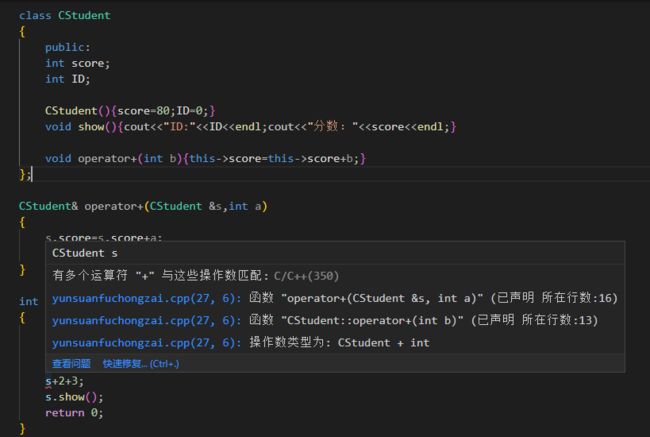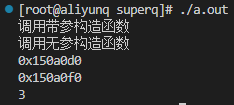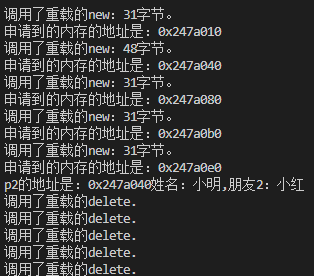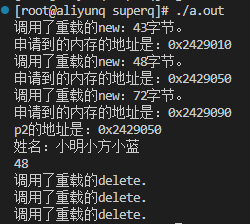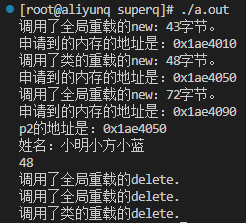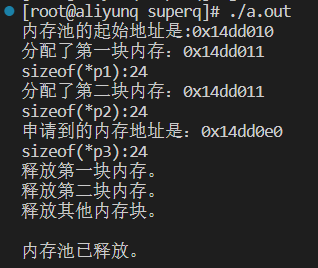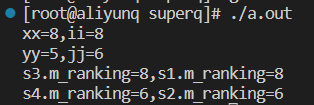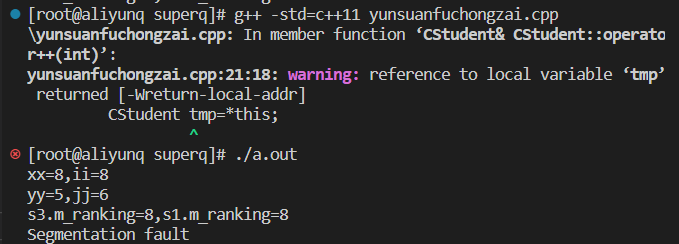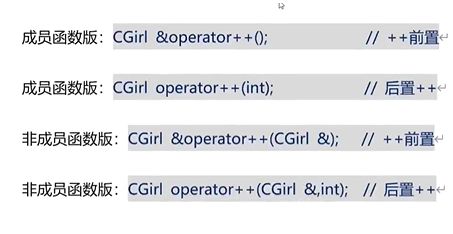C++运算符重载
运算符重载
- 运算符重载
-
- 一、重载‘+’运算符
-
- 1.非成员函数版本重载
- 2.成员函数版本
- 二、重载关系运算符
- 三、重载左移运算符
- 四、重载下标运算符
- 五、重载赋值运算符
- 六、重载new和delete
-
- 1.重载
- 2.内存池
- 七、重载括号运算符
- 八、重载一元运算符
运算符重载
C++将运算符重载扩展到自定义的数据类型,它可以让对象操作更美观。
例如字符串string用加号(+)拼接,cout用两个左尖括号(<<)输出。
语法:返回值 operator 运算符(参数列表)
非成员函数版本的重载运算符函数:形参个数与运算符操作数个数相同;
成员函数版本的重载运算符函数:形参个数比运算符的操作数个数少一个,其中一个操作数隐式传递了调用对象。
一、重载‘+’运算符
1.非成员函数版本重载
#include空返回值的运算符重载有个弊端,就是在同一条语句下不能连续使用,如:
如果需要在同一条语句中连续使用,返回值类型不能为空。如下所示:
#include2.成员函数版本
#include同理,返回值类型为void 时,运算符在同一条语句中不能连用,需将返回值返回一个对象引用
#include注意事项:
返回自定义数据类型的引用可以让多个运算符表达式串联起来。(不要返回局部变量的引用)
重载函数参数列表中的顺序决定了操作数的位置。
重载函数的参数列表中至少有一个是用户自定义的类型,防止程序员为内置数据类型重载运算符。
如果运算符重载既可以是成员函数也可以是全局函数,应该优先考虑成员函数,这样更符合运算符重载的初衷。
重载函数不能违背运算符原来的含义和优先级。
不能创建新的运算符。
以下运算符只通过成员函数进行重载:
= 赋值运算符
()函数调用运算符
[]下标运算符
->通过指针访问类成员的运算符
二、重载关系运算符
关系运算符有:==、!=、>、>=、<、<=用于比较两个自定义数据类型的大小。重载关系运算符时尽量使用成员函数版本。
#include三、重载左移运算符
重载左移运算符(<<)用于输出自定义对象的成员变量,在实际开发中很有价值(调试和日志) 只能使用非成员函数版本。
如果输出对象的私有成员,可以配合友元一起使用。
语法:
ostream& operator<<(ostream& cout,constant type& rhs)
{
cout<<rhs.xxx<<……<<endl;
return cout;
}
示例:
#include四、重载下标运算符
如果对象中有数组,重载下标运算符[],操作对象中的数组将像操作普通数组一样方便。
下标运算符必须以成员函数的形式进行重载。
语法:
返回值类型 &operator 或者:const 返回值类型 &operator[](参数)const
使用第一种声明方式,[]不公可以访问数组元素,还可以修改数组元素。 使用第二种声明方式,[]只能访问不能修改数组元素。
在实际开发中,两种都要提供,目的是为了迁就常对象,因为常对象不能访问非常函数。
看下面的例子:
#include#include
#include#include#include#include#include#include
#include#include#include#include五、重载赋值运算符
C++编译器可能会给类型添加四个函数:
默认构造函数,空实现。
默认析构函数,空实现。
默认挎贝构造函数,对成员变量进行浅挎贝。
默认赋值函数,对成员变量进行浅挎贝。
对象的赋值运算是用一个已经存在的对象,给另一个已经存在的对象赋值。
如果类的定义中没有重载赋值函数,编译器就会提供一个默认的赋值函数。
如果类中重载了赋值函数,编译器将不提供默认赋值函数。
请看下面的例子:
#include#include#include对数组来说,这是一种深挎贝:
int main()
{
CStudent s("小明",88,79,92);
CStudent s1;
cout<<s.friends<<endl;
s1=s;
cout<<s1.friends<<endl;
cout<<s1.friends[1]<<endl;
return 0;
}
重载赋值函数语法:类名 & operator=(const 类名 & 源对象)
#include编译器默认的赋值函数是浅挎贝。如果对象中不存在堆区内存空间,默认赋值函数可以满足需求,否则需要深挎贝。
赋值运算和挎贝构造不同:拷贝构造是指对象不存在,用已存在的对象进行构造;赋值运算是指已经存在了两个对象,把其中一个对象的成员变量的值赋给另一个对象的成员变量。
#include如果对象中存在堆内存空间,一定要在构造函数中初始化对象,否则会产生意想不到的异常。如下:
#include改进:
#include六、重载new和delete
1.重载
重载new和delete运算符的目的是为了自定义内存分配的细节。(内存池:快速分配和归还,无碎片)
在c++中,使用new时,编译器做了两件事:
1)调用标准库函数operator new()分配内存;
2)调用构造函数初始化内存;
使用delete时,也做了两件事情:
1)调用析构函数;
2)调用标准库函数operator delete()释放内存。
构造函数和析构函数由编译器的调用,我们无法控制。但是可以重载内存分配函数operator new()和释放函数operator delete();
1.重载内存分配函数语法:void* operator new(size_t size);
参数必须是size_t,返回值必须是void*.
2.重载内存释放函数的语法:void operator delete(void* ptr)
参数必须是void (指向由operator new()分配的内存),返回值必须是void .
重载的new和delete时,尽管不必显式地使用static,但实际上仍在创建static成员函数。
void表示该指针指向的是一块与类型无关的内存空间
下面演示为整型变量动态分配内存:
#include下面演示为类动态分配内存:
#include
#includeint test[5];
cout<<sizeof(p2->test)<<endl;
执行结果:
说明:对于像数组这样的静态指针来说,sizeof是可以识别出它所指向的内存大小的。
#include#include为一个类重载New和delete时,尽管不必显式地使用static,但实际上仍在创建static成员函数。
编译器看到使用new创建自定义类的对象时,它选择成员版本的operator new()而不是全局版的new().
new[]和delete[]也可以重载。
2.内存池
预先分配一大块内存空间
提升分配和归还速度
减少内存碎片
#include七、重载括号运算符
括号运算符也可以重载,对象名可以当成函数来使用(函数对象、仿函数)。
括号运算符重载函数的语法:
返回值类型 operator()(参数列表)
注意:
括号运算符必须以成员函数的形式进行重载。
括号运算符重载函数具备普通函数全部的特征。
如函数对象与全局函数同名,按作用域规则选择调用的函数
请看下面例子:
#include#include#include函数对象的用途:
1)表面像函数,部分场景中可以代替函数,在STL中得到广泛的应用;
2)函数对象的本质是类,可以用成员变量存放更多的信息;
3)函数对象有自己的数据类型;
4)可以提供继承体系。
八、重载一元运算符
一元运算符通常出现在它们所操作的对象的左边。
但是,自增运算符++和自减运算符–有前置和后置之分。
为了解决这个问题,C++规定,在重载++或–时,允许写一个增加了int形参的版本,编译器处理后置表达式时,
以下代码编译会报错:
#include再看下面的代码:
#include#include如何解决?返回对象的引用:
#include如何重载后置++?
#include#include再看下面的例子:
#include改进方法:
CStudent operator++(int)
{
CStudent tmp=*this;
m_ranking++;
return tmp;
}
但注意函数的返回值不能是引用,否则:
CStudent &operator++(int)
{
CStudent tmp=*this;
m_ranking++;
return tmp;
}
学习链接




